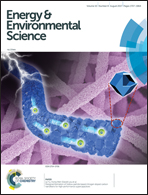A room-temperature liquid metal-based self-healing anode for lithium-ion batteries with an ultra-long cycle life†
Abstract
Benefiting from fluidity and surface tension, materials in a liquid form are one of the best candidates for self-healing applications. This feature is highly desirable for improving the life cycle of lithium-ion batteries (LIBs) because the volume expansion/contraction during the cycles of high-capacity anodes such as Si and Sn can result in mechanical fracture and lead to inferior cycle performance. Here, we report a novel room-temperature liquid metal (LM) as the anode to improve the cycle life of LIBs. The LM anode comprises an alloy of Sn and Ga, a liquid at room temperature with inherent self-healing properties, as confirmed by the in situ and ex situ analyses. Because both Ga and Sn have high theoretical capacities (769 and 990 mA h g−1, respectively), the resulting LM anode delivers a high capacity of 775, 690, and 613 mA h g−1 at the rate of 200, 500, and 1000 mA g−1, respectively. There was no obvious decay in more than 4000 cycles with a capacity of ∼400 mA h g−1 at 4000 mA g−1, realizing the best cycle performance among all metal anodes.



 Please wait while we load your content...
Please wait while we load your content...